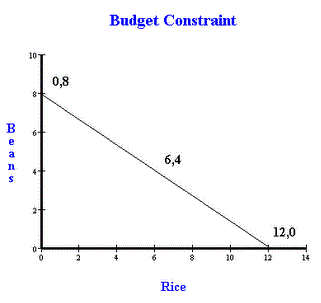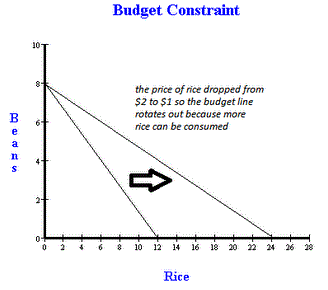Do you want BuboFlash to help you learning these things? Or do you want to add or correct something? Click here to log in or create user.
Subject 3. The Opportunity Set
#cfa #cfa-level-1 #economics #has-images #microeconomics #reading-14-demand-and-supply-analysis-consumer-demand
Assume a world with only two consumer goods, X and Y. Px is the price of good X. X is also the quantity of good X that is purchased by the consumer. Px x X is the consumer's expenditure on good X.



Total expenditure is Px x X + Py x Y.
M is the consumer's income or budget. The consumer cannot spend more than her budget allows. Px x X + Py x Y <= M is the consumer's budget constraint.
To draw a budget constraint, a line that shows the maximum amount of goods a buyer can purchase with her available funds, you need to know two things: 1) how much money she has, and 2) the prices of the two goods being considered.
Assume a consumer has an income of $24. The two goods are rice (price: $2) and beans (price: $3).

This is the basic budget line. Its slope is an indication of relative prices ($2/$3).

This is when the price of rice decreases and the consumer can purchase more rice.

When income doubles, the line will shifts outward, parallel to the original constraint.
Similarly, a company's production opportunity set represents the greatest quantity of one product that a company can produce for any given amount of the other good it produces. The investment opportunity set represents the highest return an investor can expect for any given amount of risk undertaken.
If you want to change selection, open original toplevel document below and click on "Move attachment"
Summary
| status | not read | reprioritisations | ||
|---|---|---|---|---|
| last reprioritisation on | suggested re-reading day | |||
| started reading on | finished reading on |
Details
Discussion
Do you want to join discussion? Click here to log in or create user.